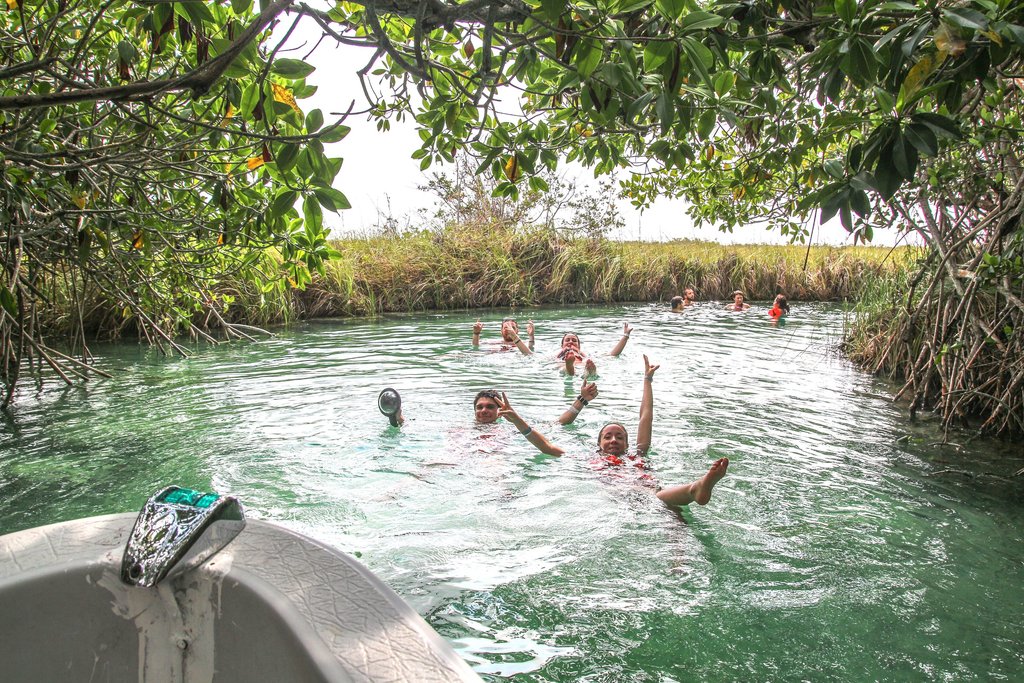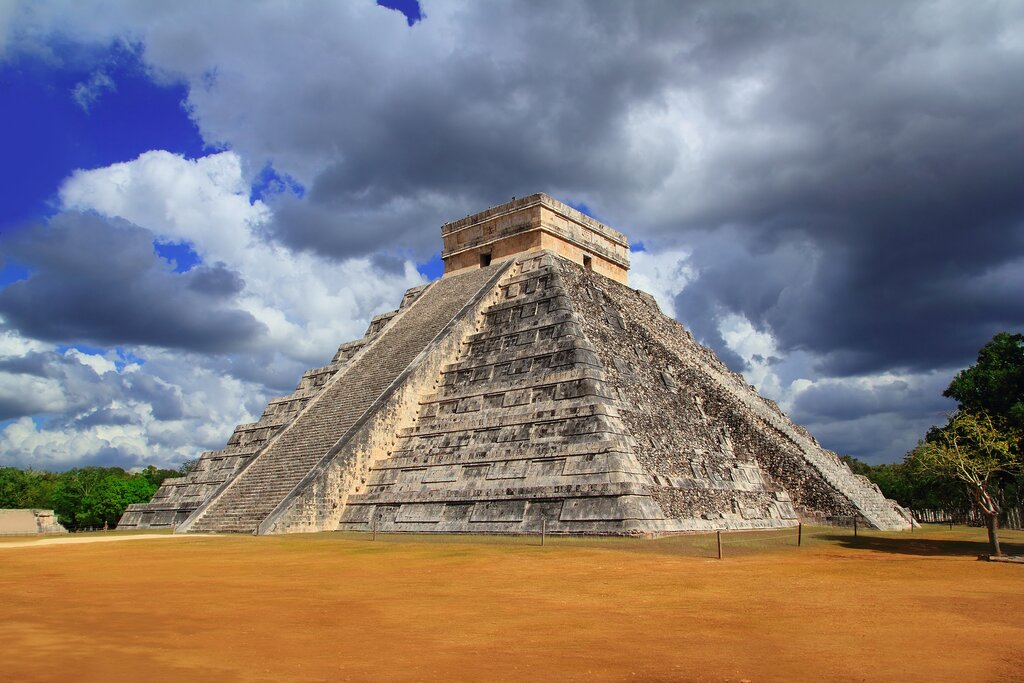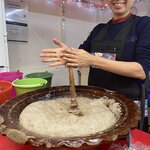Highlights
- Take a culture and foodie tour of Mexico City
- Hike the Pyramid of the Sun in Teotihuacan
- Tour the Maya ruins at Tulum, on the Caribbean coast
- Visit Chichen Itza and colonial villages in the Yucatan
- Enjoy some hammock time on laid-back Holbox Island
Brief Itinerary
| Day | Highlights | Overnight |
|---|---|---|
| Day 1 | Arrive in Mexico City, History, Culture & Gastronomy Tour | Mexico City |
| Day 2 | Day Trip to Xochimilco | Mexico City |
| Day 3 | National Museum of Anthropology & Spirits of Mexico Tour | Mexico City |
| Day 4 | Bike Tour of Teotihuacán | Mexico City |
| Day 5 | Mexico City to Tulum, Optional Activities | Tulum |
| Day 6 | Day Trip to Muyil Sian Ka'an Biosphere Reserve | Tulum |
| Day 7 | Guided Tours of Cobá & Nuevo Durango, Drive to Chichén Itzá | Pisté |
| Day 8 | Morning Tour of Chichén Itzá, Drive to Valladolid, Optional Activities | Valladolid |
| Day 9 | X'Canché Cenote & Village Tour | Valladolid |
| Day 10 | Ferry to Holbox, Optional Activities | Holbox |
| Day 11 | Three Islands Tour | Holbox |
| Days 12-13 | Free Days in Holbox | Holbox |
| Day 14 | Drive to Puerto Morelos, Optional Activities | Puerto Morelos |
| Day 15 | Return to Cancún, Depart |
Detailed Itinerary
Day 1: Arrive in Mexico City, History, Culture & Gastronomy Tour

Welcome to Mexico! This beautiful Latin American nation is full of history, art, music, and some of the most delicious food in the world. The adventure begins in the nation's capital: Mexico City. Upon arrival at the airport, a personal driver will pick you up for the transfer to your hotel. After settling in, you'll head out and stretch your legs on a four-hour walking tour of "DF" (Distrito Federal), as the locals call this city. On tour, you'll marvel at the historic architecture while enjoying Mexico's renowned gastronomy.
It begins in the Centro Histórico (historic center), a UNESCO World Heritage Site home to many colonial and Aztec landmarks. You'll visit the Palacio de Bellas Artes (a white-marble cultural center and concert hall built in 1905), the pedestrian-only Madero Street, and the Plaza de la Constitución, better known as Zócalo. This massive public square is home to historic buildings like the Metropolitan Cathedral (built over a period of 250 years beginning in 1573), the 16th-century National Palace, and the ruins of the 14th-century Templo Mayor, once a principal temple of the Aztec Empire.
During the tour, you'll periodically stop to indulge in the local street food. Sample traditional favorites like the famous tacos al pastor and quesadillas with melted cheese and huitlacoche, also known as Mexican truffle. If you have room, enjoy a dessert of fresh hot churros dusted with sugar and cinnamon. As you go, you'll realize that there's an incredible variety of delectable tidbits in this former Aztec capital, and in every bite is a taste of Mexico City's history and culture.
Day 2: Day Trip to Xochimilco

After breakfast, a driver will take you to the far south of the city for a two-hour tour of Xochimilco, one of the most colorful areas around the capital. This UNESCO World Heritage Site has been settled since pre-colonial times and is known for its tranquil canals—remnants of the rivers that once crossed the valley floor of Mexico and were used by the Aztecs for transport.
The visit includes a ride on a trajinera (a brightly painted, gondola-like boat). As you float down these half-natural, half-artificial waterways, boats filled with mariachis will float past and serenade you. You'll also learn about the area's ancient history, such as the Aztecs' ingenious techniques for growing food on the fertile riverbeds. One such technique is the chinampa, a type of floating garden that's still in use today. Even the name Xochimilco is an Aztec word that translates to "Place of Flowers." After the tour, you'll return to your hotel.
Day 3: National Museum of Anthropology & Spirits of Mexico Tour

Today you'll enjoy a 2.5-hour guided tour of one of the most important museums in Latin America. The Museum of Anthropology is an architectural marvel built in the 60s by architect Pedro Ramírez Vázquez. Its 23 rooms and outdoor exhibit spaces are home to the world's largest collection of ancient Mexican art. There are many pre-Columbian sculptures and ethnographic exhibits about modern-day Indigenous groups. Highlight items include the Aztec Calendar, The Olmec colossal head (a giant stone head carved out of basalt), and the jade mask of the Zapotec Bat God.
Hopefully, you're thirsty after the museum because now it's time for a drink. During a 90-minute tasting, you'll sample the four quintessential Mexican beverages made from the agave plant: pulque, mezcal, and tequila. It begins at the Mercado de San Juan. Here you'll learn about mezcal production and how it achieves its smoky flavor. Then taste artisanal mezcals from the states of Oaxaca, Durango, and Guerrero. You'll also try bacanora, a liquor exclusively produced in Sonora. Learn the origins of tequila as well as the differences between the young, reposado, and añejo varieties.
From the San Juan Market, you'll visit an iconic pulquería to taste "the blood of the gods," as pulque was known to the Aztecs. It's the final result of the aguamiel (sap) fermentation obtained from the maguey plant, a specific type of agave. You'll sample traditional pulque and pulque curado (infused with flavors such as marzipan or walnut). At the same time, your guide explains the history of this plant and the beverages that derive from it. As you sip, be sure to admire the Aztec art on the walls.
Day 4: Bike Tour of Teotihuacán

In the morning, your guide will pick you up at the hotel for the drive outside the city to one of the most impressive archaeological sites in Mexico: Teotihuacán. Known as the "City of the Gods," this 8-sq-mile (20-sq-km) site was founded as early as 400 BCE, meaning it long pre-dates the Aztecs. During its heyday (around 500 CE), it was home to 200,000 people and over 2,000 buildings, making it the largest city in the western hemisphere. Rather than taking a walking tour of its wide pathways, you'll experience Teotihuacán a bit differently—on a bicycle.
Upon arrival, you'll hop on a bike and cycle around the archaeological site, first passing the many murals that decorate the structures and depict cultural and religious motifs and natural landscapes. Then travel down the Avenue of the Dead, Teotihuacán's main path that runs for about a mile (2 km). You'll also visit the Pyramid of the Sun, the largest structure at 215 feet (66 m), and the Pyramid of the Moon, which towers 140 feet (43 m). Then stop at the Temple of Quetzalcoatl (Temple of the Feathered Serpent), which has bas-reliefs of the feathered serpent deity carved into its sides. After this full-day tour, you'll return to your hotel in Mexico City.
Day 5: Drive to Tulum, Optional Activities

Your driver will pick you up in the morning and transfer you to the airport for your short flight to Cancún. Located at the northeast tip of Mexico's beautiful Yucatán Peninsula, Cancún is a tourist hotspot known for its white-sand beaches fronting turquoise Caribbean waters. It's also at the doorstep of Mexico's famous Riviera Maya, a section of gorgeous coast spanning over 100 miles (160 km) that includes resort areas like Playa del Carmen and Tulum, the latter of which is where you're headed today. A driver will meet you at the airport, and from there, it's a scenic two-hour drive to Tulum.
Upon arrival in Tulum, you'll check in to your hotel and have free the remainder of the day. You'll want to head out and visit the main attraction: Tulum's famous archaeological site. The ruins here once comprised a great Maya fortress city (the word tulum is a Yucatán Mayan word meaning "wall") built on 39-foot (12-m) cliffs overlooking the ocean. On a tour of the site, which dates to 1200 CE, you can visit the famous El Castillo. This iconic fortress stands 25 feet (7.5 m) tall and overlooks the sea. Afterward, head directly below the ruins for a swim at Playa Ruinas.
Day 6: Day Trip to Sian Ka'an Biosphere Reserve

In the morning, you'll head out on a full-day hiking tour of nearby Sian Ka'an, a biosphere reserve, and the Unesco World Heritage Site. This is one of the largest protected areas in Mexico, covering over 2,000 sq miles (5,180 sq km). Within the site are natural wonders like tropical forests, palm savannas, wetlands, mangroves, lagoons, and unspoiled coastlines. The region's sheer beauty is represented in its name—in the Mayan language, Sian Ka'an means "origin of the sky." Today's activity is part of a community-based ecotourism cooperative focusing on conservation and a commitment to responsible tourism.
You'll arrive at a community center where you'll join your tour group and start the excursion. After hiking for a while on a jungle trail, you'll arrive at the temple ruins at Muyil, an ancient Maya site settled in 300 BCE. Continue hiking until you reach the edge of the turquoise Chunyaxche Lagoon, where you'll ride a boat through a mangrove channel and arrive at a small dock. Once there, you can take a refreshing dip in the water. The absolute joy here is floating slowly along the channels amid the peaceful surroundings and listening to the calls of howler monkeys and exotic birds in the trees.
After the swim, you'll head back to the community center, where you'll find a hearty meal. Then it will be time to return to your hotel in Tulum.
Day 7: Guided Tours of Cobá & Nuevo Durango, Drive to Chichén Itzá

In the morning, you'll leave Tulum and head northwest into the interior of the Yucatán, stopping at a couple of interesting places along the way. First, you'll enjoy a guided bicycle tour of the ancient Maya archaeological site in the town of Cobá. As you cycle along the ancient white pathways, you'll marvel at the ruins of this former metropolis whose heyday was between 600-900 CE. The real highlight is hiking up the 120 stone steps of Nohoch Mul, which, at 137 feet (41 m), is the tallest pyramid in Yucatán. Once at the top, you'll be rewarded with incredible views of the surrounding jungle.
After touring the Cobá ruins, you'll continue north to Nuevo Durango, a small village known for its underground caves, ecotourism projects, and organic farms. Tourism has little touched this charming community, and thus the residents have retained their customs and culture. Here you'll enjoy a traditional meal with the family of Don Manuel, who operates a project for the conservation of endangered animals. As you learn about Don's work, you'll see a few of the region's endemic species. Also, there is an insectarium, which holds a variety of spiders, scorpions, and butterflies.
Say goodbye to Manuel and his family and then continue into the heart of the Yucatán and the village of Pisté. Few would know this town if it weren't the location of one of the New Seven Wonders of the World: Chichén Itzá. This is the most famous ancient Maya archaeological site in Yucatán, and it routinely draws over two million visitors annually. En route to Pisté, you'll stop at the Punta Laguna Nature Reserve for a boat ride across the lagoon. It's an excellent opportunity to do some wildlife spotting—notably the countless spider monkeys that populate the area.
Day 8: Morning Tour of Chichén Itzá, Drive to Valladolid, Optional Activities

Chat with a local specialist who can help organize your trip.
Start the morning with a 3.5-hour walking tour of Chichén Itzá. This UNESCO World Heritage Site covers 4 sq miles (10 sq km) and was first settled in the 5th century. It then enjoyed an impressive 1,000-year run as one of the great cities in the ancient Maya kingdom before declining around 1440. Highlight ruins you'll see include the iconic El Castillo (a majestic pyramid that rises 79 feet/24 m), the Jaguar Temple, the House of Eagles (a ceremonial platform), El Caracol (a circular observatory), plus the largest ball court in Mesoamerica.
After Chichén Itzá, hop in the car and drive about 40 minutes east to the historic city of Valladolid, one of Mexico's celebrated Pueblos Mágicos (Magical Towns). This is a very special designation that the country has bestowed on some 132 places that have demonstrated historical importance, rich culture, great symbolism, and exceptional beauty. Valladolid, for example, is famous for its well-preserved 16th-century Spanish-colonial buildings. Upon arrival, you'll check in to your hotel and have the remainder of the day to take a self-guided walking tour.
One major landmark is the San Servacio Church, which dates to 1545 and overlooks the Parque Francisco Canton. The town's main plaza is filled with leafy trees, fountains, and street vendors in traditional dress operating wooden push carts. If the mood strikes, take a ride in a horse-drawn carriage around the historic center or hop in a car for the short drive to Cenote Zaci lagoon, near the city's heart. Another highlight is the Regional Museum, which charts the area's history from pre-colonial times through the founding of Valladolid and beyond.
And for a traditional culinary experience favored by the locals, head to the plaza to enjoy typical Yucatecan dishes (many of which originated in Valladolid). Try the lomitos (pork loin in tomato sauce), longaniza de Valladolid (smoked pork sausage with achiote), or the escabeche oriental (a stew made with chicken marinated in a variety of spices and cooked in orange juice, fried, then served with chiles). For dessert, grab a churro from a street vendor or the more typical marquesita, a type of rolled crepe filled with cheese, chocolate, fruit, or other goodies and grilled until crisp.
Day 9: X'Canché Cenote & Village Tour

After breakfast, you'll ride a bicycle (or take a bike taxi) along an ancient, 1.5-mile-long stone path called a sacbé (a Maya word meaning "white road"). This causeway leads to Cenote X'Canché. Cenotes are limestone sinkholes found throughout the Yucatán Peninsula and fed by the largest underground aquifer in the world. After a Yucatecan lunch, you'll dive into X'Canché for a swim. Then visit nearby Ek' Balam, the remains of a Maya city that, during its heyday around 800 CE, was the capital of the surrounding political region. Highlight ruins include temples, a ball court, and an acropolis.
Next, you'll head to the nearby Indigenous village for a walking tour of the community. During your time here, you'll visit three homes to meet local Maya families and experience the routine of daily life. They'll also impart some cultural traditions: learn how to make tortillas by hand, see how hammocks are knitted, and take part in an embroidery workshop. After the tour, you'll return to your hotel in Valladolid.
Day 10: Ferry to Holbox, Optional Activities

In the morning, you'll hit the road again on a three-hour drive to the northernmost tip of the Yucatán Peninsula. Eventually, you'll arrive in the seaside town of Chiquilá, and from there, take a 15-minute ferry to the island of Holbox. This sleepy island couldn't be more different than the tourist hotspot of Cancún, which is just a couple of hours away. There are no paved roads here, as most people get around on foot, bicycle, or golf cart. And while there are many activities on offer, one of the most popular is whiling away the hours lazing in a hammock perched on the shallow turquoise waters of Holbox's shores.
Upon arrival, you'll check into your hotel and have the remainder of the day to do as you like. Maybe take a stroll around this colorful village, filled with incredible street art, and stop at a café to try the local cuisine (the lobster pizza is particularly delicious). Or rent a golf cart and explore the island on four wheels. You can also head out from the main port to the long, white-sand beaches to swim in the crystalline waters. Then enjoy a coco (coconut) or tropical adult beverage as you sit on the sand, and marvel at Holbox's famous golden sunsets tinged with vermillion hues.
Day 11: Three Islands Tour

Today you'll enjoy one of the most popular excursions in Holbox: the Three Islands tour. As the name suggests, on this half-day boat tour, you'll visit three of the most stunning islands in the area. First and foremost, this is a nature excursion, as the locales you'll visit are home to abundant wildlife.
The first stop is at the Yalahau Lagoon, a natural cenote and habitat for various animal species, including dolphins and flocks of pink flamingoes that congregate here from April to October. Then you'll stop at Isla Pájaros (Bird Island), a protected area home to dozens of bird species, including frigates, cormorants, herons, and more. Continue to Passion Island, an idyllic place famous for its beaches covered in bright pink seashells.
Days 12-13: Free Days in Holbox

Day 14: Drive to Puerto Morelos, Optional Activities

In the morning, you'll leave Holbox and travel about four hours southeast to Puerto Morelos, located on Yucatán's Caribbean coast. This is the very definition of a sleepy Mexican fishing village, but there are several attractions in the area. Besides the surrounding jungle and nearby cenotes, Puerto Morelos is famous for its National Reef Park. This marine reserve protects a nearby section of the Mesoamerican Barrier Reef, the largest reef in the world after Australia's Great Barrier Reef.
After checking in to your hotel, you'll have free the remainder of the day in Puerto Morelos. The most exciting thing to do is head out for a two-hour snorkeling trip in the marine park. All snorkeling/diving tours here are led by certified guides (it's mandatory), and within this nearly 150-acre park, you'll see a wide array of marine life. These include tropical fish congregating around a variety of colorful corals like brain and elk-horn coral. You'll also see rays, octopuses, parrotfish, barracudas, starfish, sea snails, turtles, and many more species.
Day 15: Return to Cancún, Depart






